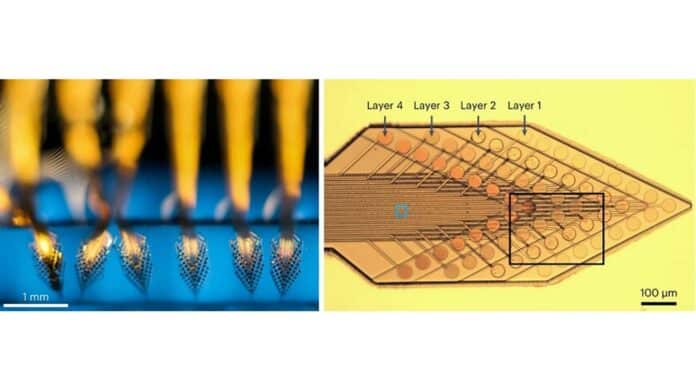Recording devices for monitoring neural activity in the nervous system must be able to scale across large spatial and temporal scales while offering millisecond and single-cell spatiotemporal resolution. However, current high-resolution neural recording devices face a challenge in achieving simultaneous scalability on both spatial and temporal levels. This is because existing devices have a tradeoff between sensor density and mechanical flexibility.
A collaborative team of researchers from the Harvard John A. Paulson School of Engineering and Applied Sciences (SEAS), along with partners from The University of Texas at Austin, MIT, and Axoft, Inc., has developed a soft implantable device, which incorporates dozens of sensors and is capable of recording single-neuron activity in the brain steadily over several months.
Paul Le Floch, first author of the paper and former graduate student in the lab of Jia Liu, Assistant Professor of Bioengineering at SEAS, said, “We have developed brain–electronics interfaces with single-cell resolution that are more biologically compliant than traditional materials. This work can potentially revolutionize the design of bioelectronics for neural recording and stimulation and for brain–computer interfaces.”
To address the tradeoff between high-resolution data rate and longevity, the researchers utilized fluorinated elastomers, which include fluorinated compounds like Teflon. These materials are resilient, biofluid stable, exhibit excellent long-term dielectric performance, and are compatible with standard microfabrication techniques.
The researchers developed a long-lasting probe by integrating these fluorinated dielectric elastomers with stacks of soft microelectrodes comprising 64 sensors. This probe is 10,000 times more delicate than conventional flexible probes from engineered plastics like polyimide or parylene C. The team successfully demonstrated the device in vivo by recording neural information from the brains and spinal cords of mice over several months.
Liu, the corresponding author of the paper said, “Our research highlights that, by carefully engineering various factors, it is feasible to design novel elastomers for long-term-stable neural interface. This study could expand the range of design possibilities for neural interfaces.”
Le Floch said, “Designing new neural probes and interfaces is a very interdisciplinary problem that requires expertise in biology, electrical engineering, materials science, mechanical and chemical engineering.”
Journal Reference:
- Le Floch, P., Zhao, S., Liu, R. et al. 3D spatiotemporally scalable in vivo neural probes based on fluorinated elastomers. Nat. Nanotechnol. (2023). DOI: 10.1038/s41565-023-01545-6
